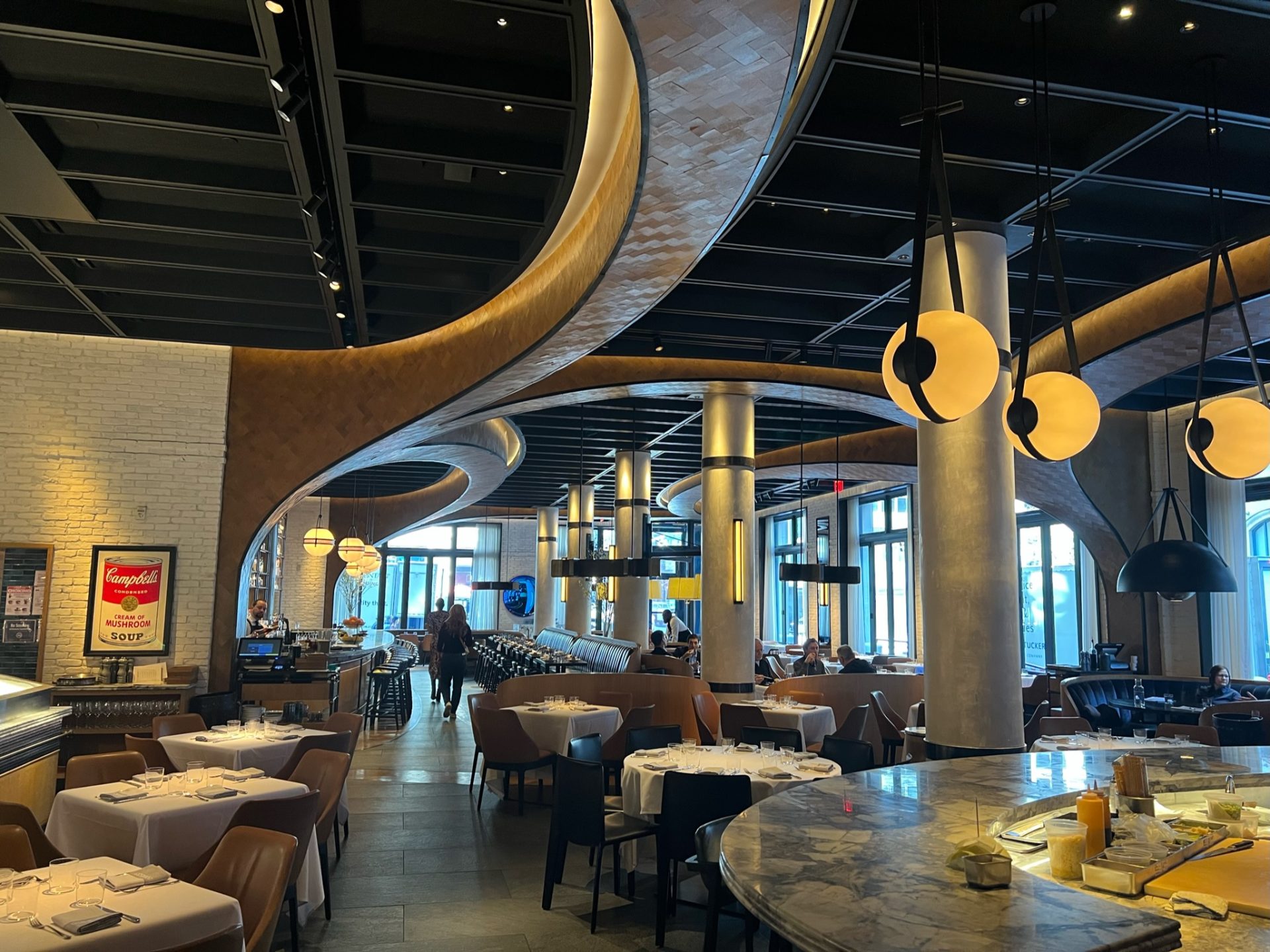Fine Dining Experience Islamabad: Indulge in Lavish Culinary Pleasures
Fine Dining Experience Islamabad: Indulge in Lavish Culinary Pleasures
Blog Article
Savor Authentic Asian Cuisine With a Pan-Asian Twist for a Cooking Journey
Starting a cooking trip through genuine Oriental food, improved with a Pan-Asian twist, supplies an one-of-a-kind opportunity to explore the abundant tapestry of tastes that specify the area's varied culinary practices. This experience welcomes you to savor the exquisite equilibrium of preferences-- sweet, salted, spicy, and sour-- balanced by fragrant natural herbs and spices. Picture the ingenious fusion of Thai curry and ramen or the unanticipated pleasure of sushi burritos. As you consider these tempting meals, think about the cultural narratives and historical impacts that form them, each bite supplying a story waiting to be found.

Discovering Pan-Asian Tastes
In the realm of global gastronomy, Pan-Asian food attracts attention for its impressive diversity and the harmonious interplay of flavors from numerous Asian societies. This cooking method celebrates the one-of-a-kind active ingredients and abundant traditions found across the continent, producing a tapestry of tastes that is both rewarding and intriguing. Trick to Pan-Asian cuisine is its capacity to stabilize different flavors-- pleasant, salty, spicy, and sour-- while highlighting the quality and quality of each ingredient.
From the umami-rich soy sauce of Japan to the fiery chili peppers of Thailand, Pan-Asian cuisine offers a considerable combination of tastes. These elements are frequently incorporated in inventive ways, enhancing recipes with layers of complexity. As an example, using great smelling herbs such as lemongrass and cilantro, usual in Vietnamese and Thai food, includes a refreshing brightness to dishes, while the consolidation of coconut milk supplies a creamy, abundant appearance.
The focus on fresh produce and fragrant flavors ensures that each meal is not only a feast for the taste yet also for the senses. Pan-Asian food welcomes diners to start a culinary trip, checking out the vast and differed landscapes of Oriental gastronomy with every bite.
Fusion Meals to Attempt
While Pan-Asian cuisine is celebrated for its traditional flavors, the contemporary cooking landscape is significantly embracing blend meals that mix these classic aspects with influences from other areas. This ingenious approach not just honors the rich heritage of Asian culinary arts yet additionally introduces novel taste experiences that attract modern tastes buds.
A prime example of such a blend meal is the Korean-Mexican taco, where marinated bulgogi beef is covered in a warm tortilla, covered with kimchi and a hot gochujang-infused salsa. This mix weds the bold, savory tastes of Korea with the vivid, fresh elements of Mexican food. In a similar way, sushi burritos have obtained popularity, joining together the delicate virtuosity of Japanese sushi with the passionate, hand-held ease of a burrito, commonly featuring fusion ingredients like tempura shrimp and avocado with a drizzle of wasabi mayo.
Another notable meal is Thai curry ramen, which instills the velvety, aromatic seasonings of Thai curry into the calming broth of traditional Japanese ramen, developing an unified mix that entices the detects. These combination dishes extend past plain novelty; they stand for a culinary discussion between societies, urging expedition and advancement worldwide of Pan-Asian food.
Vital Active Ingredients and Flavors
To absolutely value Pan-Asian cuisine, one must understand the necessary active ingredients and seasonings that form its foundation. This diverse cooking style draws from a rich tapestry of Oriental customs, using an unified blend of tastes and appearances.
Aromatic aspects are essential, with ginger, garlic, and lemongrass being common across various Pan-Asian recipes. These ingredients offer a great smelling base that improves the intricacy of tastes. Spices try these out such as celebrity anise, cardamom, and cinnamon introduce heat and personality, echoing impacts from areas like China and India.

Food Preparation Techniques and Tips
Grasping the art of Pan-Asian food needs familiarity with its distinct food preparation strategies, each adding to the vivid tapestry of tastes this culinary tradition is commemorated for. Central to these approaches is the stir-fry, a rapid cooking method that maintains the dietary honesty and vibrant colors of active ingredients. Utilizing a wok, the stir-fry method enables even heat distribution, necessary for accomplishing the particular appearance and taste equilibrium of Pan-Asian meals.
An additional basic strategy is steaming, specifically common in Chinese food. This gentle approach keeps the all-natural tastes and nutrients of active ingredients, making it perfect for fish and shellfish and vegetables. Dumplings, a cherished staple, often gain from steaming, causing soft, delicious textures.
Barbecuing, likewise important, gives smoky depths to dishes such as Korean bulgogi or Japanese yakitori (pan asian restaurant Islamabad). This strategy typically includes seasoning components, enabling tastes to pass through deeply before cooking over an open flame or hot plate
Last but not least, understanding the art of balancing tastes-- sweet, sour, salty, bitter, and umami-- is crucial. Appropriately layering these components can boost a meal from common to phenomenal, providing a complicated and satisfying culinary experience that embodies the essence of Pan-Asian cuisine.
Eating Experiences Worldwide
Throughout the globe, Pan-Asian cuisine provides an unmatched dining experience, commemorated for its abundant tapestry of flavors and lively discussions. This culinary sensation has actually gone beyond cultural borders, catching the hearts and palates of food fanatics worldwide. In cosmopolitan cities fresh York, London, and Sydney, Pan-Asian dining establishments serve as melting pots where culinary traditions from Thailand, Japan, China, and beyond converge, giving restaurants with a diverse mix of recipes that highlight the area's variety.
The antojitos international charm of Pan-Asian cuisine hinges on its capacity to use both credibility and innovation. Cooks skillfully wed traditional active ingredients such as lemongrass, soy sauce, and miso with contemporary methods, causing meals that are both acquainted and refreshingly new. This combination permits restaurants to begin on a culinary journey that respects heritage while welcoming modernity.
Additionally, eating experiences are boosted through attentively made settings that mirror the principles of Pan-Asian appearances. From minimalist Japanese-inspired interiors to vibrant Thai-themed spaces, each dining establishment supplies an unique ambiance that complements the culinary offerings. Because of this, patrons are not just consuming a meal however partaking in a social experience, making Pan-Asian dining a truly worldwide phenomenon.
Conclusion
The expedition of Pan-Asian food uses an extensive understanding of the detailed interplay of tastes and culinary traditions throughout Asia. By embracing fusion meals such as Thai curry the chef ramen and sushi burritos, the cooking journey not just highlights the flexibility of typical ingredients but also showcases cutting-edge modern techniques. This gastronomic experience, enriched by necessary spices and cooking approaches, gives an unique chance to value the cultural diversity and cooking creativity that specify Pan-Asian food on a worldwide range.
Beginning on a culinary journey via authentic Asian cuisine, enhanced with a Pan-Asian twist, offers a distinct opportunity to check out the abundant tapestry of flavors that define the region's varied culinary traditions.In the world of worldwide gastronomy, Pan-Asian food stands out for its exceptional diversity and the unified interaction of flavors from various Oriental societies. Secret to Pan-Asian food is its ability to stabilize contrasting tastes-- wonderful, salted, spicy, and sour-- while highlighting the quality and top quality of each component.

Report this page